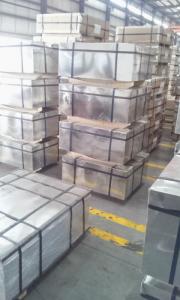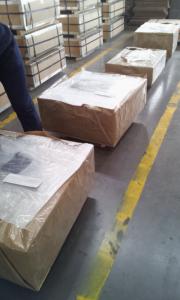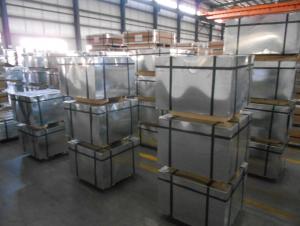Electrolytic Tinplate Sheet
- Loading Port:
- China Main Port
- Payment Terms:
- TT OR LC
- Min Order Qty:
- -
- Supply Capability:
- -
OKorder Service Pledge
Quality Product, Order Online Tracking, Timely Delivery
OKorder Financial Service
Credit Rating, Credit Services, Credit Purchasing
You Might Also Like
Please kindly refer to Specifications:
Standard | JIS G3003,BS EN 10202 |
| Material | MR, SPCC |
Thickness | 0.15-0.50mm |
| Width | 600-1050mm |
| Temper | T1-T5; DR8 |
| Coating | Both Equal and Differential Available |
Surface finish | Bright, Stone, Silver, Matt |
| Oiling | DOS |
| Coil ID | 508 mm |
| Coil weight | 3-10 MT |
| Sheet weight | 1-1.5 MT |
| Weight in one 20’ container | 20-25 MT |
| Packaging | For coils: Anti-rust paper +metal cover +corner protected +wood skid For sheets: Thin plastic film +rust-proof paper +metal cover +metal angles + straps + pallet. Loaded in 20 feet container with max weight 25 tons |
| Application | Metal Container and Mechanical Parts |
- Q:How is tinplate recycled?
- Tinplate is recycled through a process known as steel scrap recycling. First, the tinplate is collected and sorted. Then, it undergoes a shredding and melting process to separate the steel from other materials. The melted steel is purified and refined, removing any impurities. Finally, the purified steel is used to produce new tinplate products, completing the recycling cycle.
- Q:Can tinplate be used for aerosol cans?
- Yes, tinplate can be used for aerosol cans. Tinplate, which is steel coated with a thin layer of tin, is commonly used in the production of aerosol cans due to its strength, durability, and ability to resist corrosion.
- Q:What are the main advantages of using tinplate for electrical enclosures?
- One of the main advantages of using tinplate for electrical enclosures is its excellent corrosion resistance. Tinplate is coated with a thin layer of tin, which acts as a protective barrier against moisture and other corrosive elements. This ensures that the electrical components inside the enclosure remain well protected and functional for extended periods. Another advantage is its high strength and durability. Tinplate is known for its ability to withstand mechanical stress and impacts, making it a reliable choice for enclosures that may be subjected to rough handling or harsh environmental conditions. Furthermore, tinplate is a cost-effective option. It offers a good balance between price and performance, making it an economical choice for electrical enclosure manufacturers. Additionally, tinplate is easily recyclable, making it an environmentally friendly material. Overall, using tinplate for electrical enclosures provides excellent corrosion resistance, durability, and cost-effectiveness, making it a preferred choice in many applications.
- Q:What are the different types of tinplate welding techniques?
- There are several types of tinplate welding techniques, including spot welding, seam welding, and projection welding.
- Q:What are the main challenges in tinplate coating thickness control?
- One of the main challenges in tinplate coating thickness control is achieving uniformity across the entire surface of the tinplate. The coating thickness must be consistent and within the desired range to ensure proper protection and functionality of the tinplate. Additionally, controlling the coating thickness requires precise measurement and monitoring techniques as well as the ability to adjust the coating process parameters in real-time to account for any variations or deviations. Another challenge is ensuring the adhesion of the coating to the tinplate surface, as poor adhesion can lead to coating defects and reduced performance. Lastly, controlling the coating thickness while maintaining cost-effectiveness can be a challenge, as it requires optimizing the coating process to minimize material waste and reduce production costs.
- Q:How is tinplate stored and transported?
- Tinplate is typically stored in a dry and well-ventilated area to prevent corrosion. It is often stacked on pallets or stored in racks to ensure easy access and minimize the risk of damage. When it comes to transportation, tinplate is commonly transported in containers or on trucks. It is important to handle it with care to avoid any scratching or denting, which could compromise its integrity. Additionally, proper packaging and securing methods are employed to prevent movement or shifting during transportation, reducing the chances of damage.
- Q:What are the common corrosion protection methods used for tinplate?
- The common corrosion protection methods used for tinplate include electroplating, organic coatings, and lacquering. Electroplating involves depositing a layer of tin onto the surface of the tinplate to provide a barrier against corrosion. Organic coatings, such as epoxy or polyester, can also be applied to protect the tinplate from moisture and other corrosive elements. Lacquering is another method where a layer of lacquer is applied to the tinplate to create a protective barrier.
- Q:What are the main applications of tinplate in the energy industry?
- Tinplate is commonly used in the energy industry for various applications such as the production of battery casings, electrical components, and packaging for energy storage devices. Its corrosion resistance, strength, and ability to withstand extreme temperatures make it a preferred material for these purposes. Additionally, tinplate's non-reactive nature ensures the integrity of energy storage systems, making it an ideal choice for the energy industry.
- Q:How is tinplate affected by exposure to UV light?
- Tinplate is not significantly affected by exposure to UV light since it is a highly durable material with good resistance to sunlight.
- Q:How is tinplate corrosion resistant?
- Tinplate is corrosion resistant due to the thin layer of tin coating that is applied to the surface of the steel. This tin layer acts as a barrier, preventing oxygen and moisture from coming into direct contact with the steel, which helps to inhibit the formation of rust and corrosion.
1. Manufacturer Overview |
|
|---|---|
| Location | |
| Year Established | |
| Annual Output Value | |
| Main Markets | |
| Company Certifications | |
2. Manufacturer Certificates |
|
|---|---|
| a) Certification Name | |
| Range | |
| Reference | |
| Validity Period | |
3. Manufacturer Capability |
|
|---|---|
| a)Trade Capacity | |
| Nearest Port | |
| Export Percentage | |
| No.of Employees in Trade Department | |
| Language Spoken: | |
| b)Factory Information | |
| Factory Size: | |
| No. of Production Lines | |
| Contract Manufacturing | |
| Product Price Range | |
Send your message to us
Electrolytic Tinplate Sheet
- Loading Port:
- China Main Port
- Payment Terms:
- TT OR LC
- Min Order Qty:
- -
- Supply Capability:
- -
OKorder Service Pledge
Quality Product, Order Online Tracking, Timely Delivery
OKorder Financial Service
Credit Rating, Credit Services, Credit Purchasing
Similar products
New products
Hot products
Hot Searches
Related keywords




























